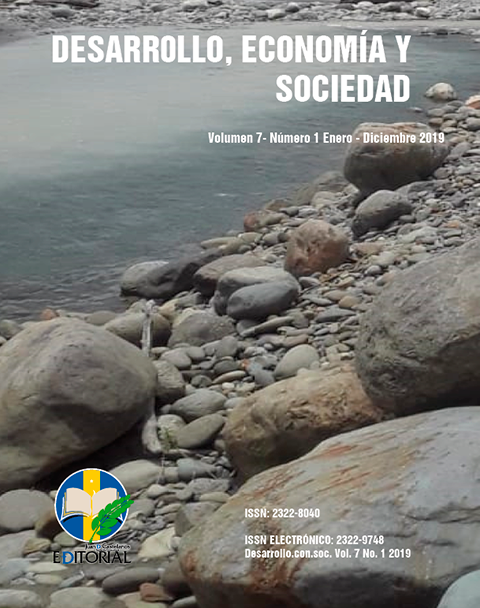Pedagogical strategy for internal conflict resolution applied to ecsan students.
DOI:
https://doi.org/10.38017/23228040.724Keywords:
mediation, leadership, pedagogy, academic model, conflicts, conflict resolutionAbstract
In the fulfillment of rights and duties for the continuous improvement of the quality of life, the National Police has had transitional changes emphasized in the fulfillment of the service, thus achieving to be recognized as one of the best police forces in the continent. One of the fundamental pillars of the institution is its human talent, since through this it is possible to plan, organize and deploy different services within the framework of a healthy coexistence, which is why their physical and emotional well-being must be aligned and in optimal conditions to face the diverse variables that they face in the provision of the same. In the same way, it is important that the National Police, with its commanders, work on a conflict resolution with their subordinates through pedagogical strategies, for this it is important to work from the students, from the Francisco de Paula Santander Police Cadet School, who they are trained as future leaders of the institution.
Downloads
References
AEDIDH. (2008). Declaración de Luarca (Asturias) sobre el Derecho Humano a la Paz. Revista paz y conflictos, 109-119. Obtenido de http://www.ugr.es/~revpaz/documentacion/rpc_n1_2008_doc1.pdf
Alzate, R. (n.d.). TEORÍA DEL CONFLICTO.
Arias, F. (2012). El proyecto de investigacion (sexta ed.). Caracas, Venezuela: Suplidora Van. Obtenido de https://es.slideshare.net/fidiasarias/fidias-g-arias-el-proyecto-de-investigacin-6ta-edicin
Asamblea General de Naciones Unidas. (1948). Declaración Universal de los Derechos Humanos. ONU. Obtenido de https://www.ohchr.org/EN/UDHR/Documents/UDHR_Translations/spn.pdf
ATLAS.ti. (2020). ATLAS.ti. https://atlasti.com/product/what-is-atlas-ti/
Bandura, A. (1987).Teoría del Aprendizaje Social. Madrid: Espasa-Calpe.
Bugala, M. (2019). Perception of conflict situations before and after graduation from the police school. https://www.semanticscholar.org/paper/Perception-of-conflict-situations-before-and-after-Bugala/0abfeb1de48e50603c4ebff89a6167a3099918f6
D’Antonio, G., Bedolla, J. S., & Chiabert, P. (2017). A Novel Methodology to Integrate Manufacturing Execution Systems with the Lean Manufacturing Approach. Procedia Manufacturing, 11(June). https://doi.org/10.1016/j.promfg.2017.07.372
De, A., Udala, V.-G., Maza, S., Sara, B., Urieta, G., Alzate Sáez De Heredia, R., Sánchez, M. L., Jesús, G.-A., Mendaza, P., Lozano, F., Laura, E., Blanco, G., Belén, M., Gómez, V., Villar Sáez De Santa, S., Luis, M., Peña, J. V., Zugazaga, J., & Edición, M. (2015). Resolucion pacifica de conflictos.
Domínguez Bilbao, R. & García Dauder, S. (2003, January). Introducción a la teoría del conflicto en las organizaciones.
ECSAN. (2018). RESOLUCION 313 DEL 14 DE MARZO DEL 2018 REGIMEN INTERNO.
Franco, G. (ECSAN). (2019). Balance plan de autogestión 2019.pdf (p. 13).
Gamboa Mora, M. C., García Sandoval, Y., & Beltrán Acosta, M. (2013). Estrategias pedagógicas y didácticas para el desarrollo de las inteligencias múltiples y el aprendizaje autónomo. Revista de Investigaciones UNAD, 12(1), 101. https://doi.org/10.22490/25391887.1162
Gómez, A. (2017). Teoria de la Educación para la paz en América Latina. Academicus, 6-19. Obtenido de http://www.ice.uabjo.mx/media/15/2017/04/Art3_1.pdf
Gómez, S., & Calvo, G. (2014). Prácticas Pedagógicas Exitosas para Educar a la Policía de Colombia Prácticas Pedagógicas Exitosas para Educar a la Policía de Colombia. Congreso Iberoamericano de Ciencia, Tecnología, Innovación y Educación Prácticas, 1–18.
Google Inc. (2020). Formularios de Google: crea y analiza encuestas de forma gratuita. https://www.google.com/intl/es-419_co/forms/about/
Hernández-Calderón, K. A., & Lesmes-Silva, A. K. (2018). La escucha activa como elemento necesario para el diálogo. Convicciones, 9(1), 83–87.
Martinez-Cola, M., English, R., Min, J., Peraza, J., Tambah, J., & Yebuah, C. (2018). When Pedagogy Is Painful: Teaching in Tumultuous Times. Teaching Sociology, 46(2), 97–111. https://doi.org/10.1177/0092055X17754120
Navarro, D. (2018). La mediación policial: una propuesta de mejora. Valencia, España: ADE. Obtenido de https://mediacionesjusticia.files.wordpress.com/2018/12/mediacionpolicial-por-davidnavarro.pdf
Palomino, R. (Policía N. (2014). manual_academico_03-10-2014_resolucion_04048 (5).pdf (p. 44). https://www.policia.gov.co/file/52099/download?token=S0EJMM3b
Policía Nacional. (2017). Mediacion policial. Bogotá D.C.: partners. Obtenido de http://www.pensamientopenal.com.ar/system/files/2018/02/miscelaneas46234.pdf
Ríos, A. L., & Ríos, A. (2014). Estudiar lo policial: Consideraciones acerca del estudio de las fuerzas de seguridad y una apuesta. Sociológica (México), 29(81), 87–118.
Secretaría del Senado. (2020). Código Civil Colombiano. Leyes desde 1992 - Vigencia expresa y control de constitucionalidad. http://www.secretariasenado.gov.co/senado/basedoc/ley_1015_2006.html
Steele Garza, J. G. (2018). Mediación policial. Un protocolo de prevención del delito y cultura de paz. Justicia, 23(34), 471–489. https://doi.org/10.17081/just.23.34.3403
Steele, J. (2018). Mediación policial. Un protocolo de prevención del delito y cultura de paz. En P. version, Justicia (Vol. 34, págs. 471-489). Barranquilla: Scielo. Obtenido de http://www.scielo.org.co/scielo.php?script=sci_arttext&pid=S0124-74412018000200471&lang=es
Downloads
Published
How to Cite
Issue
Section
License
Copyright (c) 2019 Development, Economy and Society

This work is licensed under a Creative Commons Attribution-NonCommercial-ShareAlike 4.0 International License.





